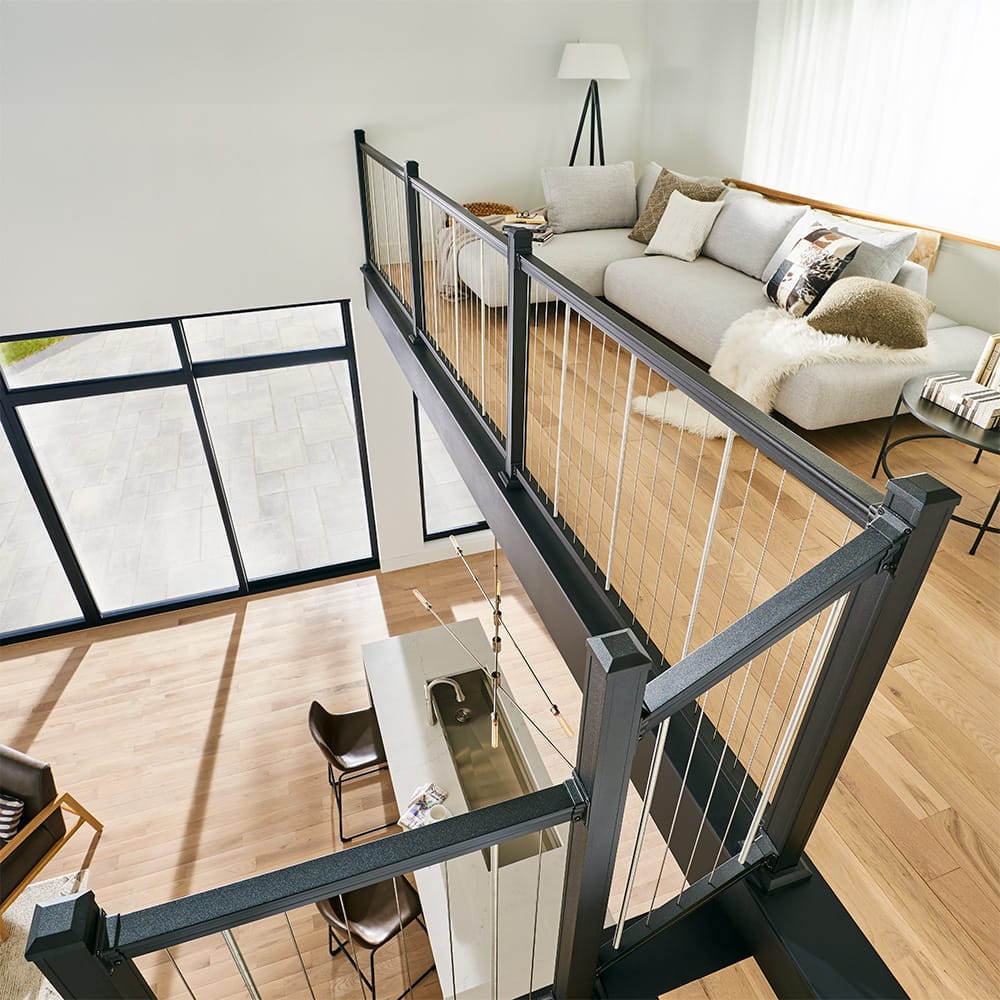Are Horizontal Railings Safe? Understanding the Ladder Effect

Horizontal cable railing and horizontal rod rail is sleek and modern. It also attracts a persistent question about the “ladder effect.” Some people worry a horizontal pattern invites children to climb. This article explains the history behind the concern, what the data shows, common myths, how codes treat horizontal infill today, and practical steps to design a safe, compliant system.
A Brief History of the Ladder Effect
The ladder effect concern started in the 1990s. It led to a short lived ban in model code, which was later removed.
In the early 1990s, code officials raised a new worry. They believed horizontal guard infill might be climbable like a ladder. The BOCA National Building Code responded by adding text discouraging horizontal members in required guards.
When the International Residential Code (IRC) launched in 2000, it carried forward a similar sentiment. The 2000 IRC included language that effectively prohibited horizontal guard patterns that could act like rungs. Builders and officials debated the topic widely. Many asked for proof that horizontal designs were causing more injuries.
In 2001, after review, the International Code Council removed the ladder effect language. The removal followed a lack of convincing evidence that horizontal infill increased child injury rates. Since then, model codes have not banned horizontal guards due to climbability. The vertical or horizontal orientation of infill is not the code focus today. Openings, strength, and height are.
| Year | What Changed | Outcome |
|---|---|---|
| 1993–2000 | BOCA adds language discouraging horizontal infill in guards. | Early ladder effect concern enters code discussion. |
| 2000 | Initial IRC edition restricts ladder-like guard patterns. | Short period of formal prohibition. |
| 2001 | ICC removes ladder effect language from the IRC. | Modern model codes no longer ban horizontal infill. |
How Safety Risk Is Understood
Code intends to prevent accidental falls. Deliberate climbing is a different problem and cannot be fully designed out.
Guard requirements aim to prevent accidental falls off elevated walking surfaces. That includes decks, balconies, and stair landings. Children sometimes climb things on purpose. A design that blocks all deliberate climbing is unrealistic. Children can climb furniture, lattice, shelving, or even vertical pickets. For this reason, code centers on measurable performance. It sets guard height. It limits opening size. It defines load resistance for the top rail and the infill.
This framework matters. It means a horizontal cable railing is evaluated on the same criteria as a vertical picket system. If both meet height, opening, and load rules, both are considered acceptable. The orientation by itself is not a failing condition.
What the Evidence Says
Documented incidents exist, but they are rare. Broad data does not show a higher injury rate from horizontal designs.
The concern often cites a small number of tragic cases. One example involved a child who climbed a horizontal rail guard and fell. Events like this matter. They also require context. Studies and injury databases have looked for trends. They have not found that horizontal guards drive a larger share of child fall injuries.
A well known review commissioned by industry groups examined decades of records. It concluded that falls from guards among toddlers represent a tiny fraction of injuries. The rate was reported as a small number per one hundred thousand children in the studied range. Researchers and code experts reached a shared view. There is no clear evidence that horizontal guards are more dangerous than other designs when built to code.
Two practical observations help explain the finding:
- Design intent: Guards prevent accidental falls. No infill pattern fully stops deliberate climbing.
- Human behavior: Young children explore. They may try to climb anything nearby, including furniture placed next to a railing.
Ladder Effect Myths and Facts
These myths persist, but the model codes and the data say otherwise.
Myth 1: Horizontal railings are against the code.
Fact: Model codes do not ban horizontal guard infill. The brief 2000-era prohibition was removed in 2001. Today, horizontal cables and bars are allowed when the guard meets height, opening, and load rules.
Myth 2: Kids will always climb horizontal railings and get hurt.
Fact: Some children climb, but the documented injury rate from guards is very low. Children can also climb vertical patterns or non-guard objects. Supervision, not infill orientation, is the key factor.
Myth 3: Horizontal cable railings are structurally weaker.
Fact: A compliant cable system resists the same top rail and infill loads required for any guard. Proper post design, spans, and cable tension are what make the system safe.
Myth 4: The ladder effect makes horizontal infill inherently dangerous.
Fact: The ladder effect was a theoretical concern. Evidence did not support a ban. Millions of code compliant horizontal systems are in safe use today.
How Codes Treat Horizontal Infill
The IRC and IBC focus on height, openings, and loads. Orientation is not the deciding factor.
Guard height. Typical residential guards are at least 36 in on level walking surfaces. Commercial and multifamily guards are usually 42 in. On stairs, guards and handrails have their own rules. A common handrail height range is 34 to 38 in measured from the tread nosings.
Openings. A 4 in sphere must not pass through any opening in the guard. On stairs, there are small exceptions. Between angled elements on stair guards, a 4⅜ in sphere is allowed. In the lower triangle at the stair nosing and bottom rail, a 6 in sphere is allowed. With cable infill, inspectors check gaps under load, not only the static spacing. This is why cable spacing and tension matter.
Loads. The top rail must resist a 200 lb concentrated load in any direction. Commercial systems also face a uniform load requirement. Infill must resist a 50 lb load over a 1 sq ft area without excessive deflection. These loads apply regardless of infill orientation.
For a deeper code walkthrough, see our companion guide, Cable Railing Code Compliance. It covers heights, spacing, load paths, post design, and inspection tips in detail.
Design Practices That Reduce Climbing
The majority of child related injuries are due to improper construction of any railing. Good design can make climbing less tempting and keep openings compliant under load.
Limit footholds and step ups
Avoid wide, flat top rails that act like a shelf. Rounded or narrow profiles are harder to stand on. Keep planters, benches, storage boxes, and furniture away from guard edges. These items can form a convenient step that defeats any guard pattern.
Dial in cable spacing
Target about 3 in on center spacing for 1/8 in cable. The code limit is a 4 in sphere, but cables deflect. Tighter spacing provides margin under push or test loads. It also gives a consistent visual rhythm that looks finished.
Control spans and add intermediates
Post spacing drives deflection. Many systems work best at 4 ft between structural posts. On longer runs, add intermediate braces or cable stabilizers every 3 to 4 ft. Shorter spans reduce both cable sag and top rail flex.
Choose the right materials
Use Type 316 stainless steel for exterior cables and fittings. Select low stretch 1x19 construction cable for rigidity. Isolate dissimilar metals to limit corrosion. In coastal or high salt areas, design for harsher conditions and plan for more frequent maintenance checks.
Installation Details That Matter
Correct tension, stout posts, and clean terminations separate a pass from a fail.
Engineer the frame for tension
Cables transfer significant horizontal force to end and corner posts. Ten to thirteen cables at common tensions can add up to well over a thousand pounds on the termination. Wood end posts may need reinforcement. Aluminum systems rely on adequate wall thickness, large base plates, and proper anchors. Avoid notching structural posts near connections.
Tension evenly and verify
Follow the system manual for target tension per cable. Work from the middle cables outward in stages. Use a gauge if specified. After first installation, recheck tension in a few weeks. Temperature swings and material movement can relax the system. Plan an annual check to keep gaps tight.
Mind drilling and alignment
Keep cable holes aligned and deburred. Misaligned holes increase friction and create uneven tension. Use sleeves or grommets where the cable changes direction to protect the wire and the post. For corners, follow the manufacturer’s minimum bend radius and hardware rules. If your route requires compound angles, use universal swivel fittings designed for that geometry.
Document compliance
Save cut sheets, engineering summaries, and test data from the manufacturer. Many pre engineered systems provide load and deflection information. This documentation helps at plan review and inspection. It also builds owner confidence that the design is not guesswork.
Local Amendments and AHJ Considerations
Model codes set the baseline. Some jurisdictions add restrictions, including climbability rules.
Most states and cities adopt the IRC or IBC with amendments. A small number still reference climbability for guards. Others increase residential guard height to 42 in. Coastal regions may require specific materials or connections. Your Authority Having Jurisdiction decides what applies at the site.
| Topic | Possible Local Variation | What To Do |
|---|---|---|
| Climbability | Some municipalities discourage or restrict horizontal infill. | Ask the building department if local amendments reference “climbable” guards. |
| Guard height | Residential guards set to 42 in instead of 36 in. | Confirm with plan review. Adjust post and panel sizes before ordering. |
| Materials | Corrosion resistance rules in coastal zones. | Specify Type 316 stainless, proper coatings, and isolation hardware. |
| Anchorage | Higher pull out or shear values for fasteners. | Match base plates, fastener grade, and anchors to the substrate and loads. |
Working With Inspectors and HOAs
Early communication reduces surprises. Bring data and show how the system meets each rule.
- Start early: Share product literature at plan review. Ask if horizontal infill is acceptable under adopted code.
- Be specific: Show guard height, post spacing, cable spacing, and tension targets on drawings.
- Prove strength: Provide engineering summaries for top rail and infill loads. Include base plate and anchor specs.
- Address openings: Note that cable spacing is set to about 3 in to protect the 4 in sphere under load.
- Prepare on site: Have a tension gauge, replacement ferrules, and spare hardware ready for inspection day.
For HOAs, include photos of installed systems, finish samples, and a statement that the design meets the city’s code. This speeds architectural review and reduces back and forth.
Temporary Safety Strategies for Young Children
You can add safeguards during early years without giving up a modern design.
If toddlers use the space daily, consider a temporary second layer. Clear panels mounted inside the guard are one option. Another is a fine, tensioned mesh that preserves views. Both can be removed later. Add self closing, self latching gates at stair entries. Keep movable items at least a few feet back from the guard line. Teach children early that a railing is a barrier, not a play structure. None of these steps replace supervision, but they create a safer day-to-day environment.
Need Help Designing a Compliant System?
We design cable railing packages that meet code and fit your space.
Get a Free QuoteFrequently Asked Questions
Are horizontal railings legal under today’s codes?
Yes. Modern model codes do not ban horizontal infill. Your system must meet the same height, opening, and load rules as any other guard. Always check for local amendments before you order materials.
Do horizontal cables increase the risk of child injuries?
Broad data does not show an elevated injury rate from horizontal guards. Children may attempt to climb many things. Supervision and good design practices are the real safety drivers.
What cable spacing should I use to pass inspection?
Plan about 3 in on center for 1/8 in cable. The code test is the 4 in sphere under load, not the static gap. Tighter spacing gives margin and a clean look.
How far apart should posts be on a cable system?
Many systems perform best with structural posts at about 4 ft. Use intermediate braces every 3 to 4 ft on longer spans to control deflection and keep openings tight.
Which materials are best for exterior cable railing?
Use Type 316 stainless cable and fittings, and 1x19 construction for low stretch. Choose posts and fasteners that match the required loads and the environment. Isolate dissimilar metals to limit corrosion.
About the Author: Jonathon Sims is the founder of Inso Supply. He helps homeowners and contractors design safe, code compliant railing systems across the United States.



Leave a comment